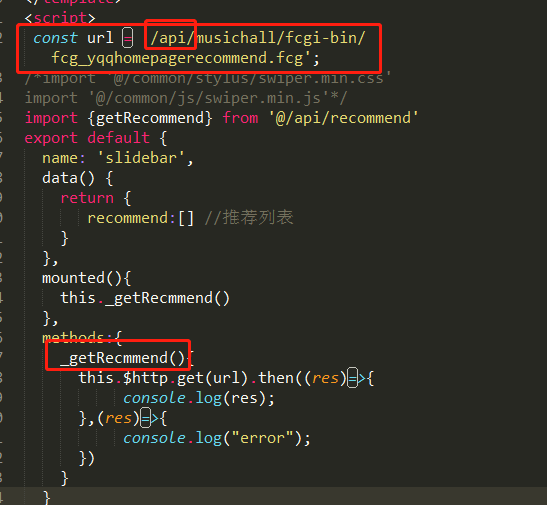这篇主要记录了在使用过程的当中,对于vue的一些方法的理解
1.Vue生命周期中mounted和created的区别
- <span style="font-size:14px;">Vue.component("demo1",{
- data:function(){
- return {
- name:"",
- age:"",
- city:""
- }
- },
- template:"<ul><li id='name'>{{name}}</li><li>{{age}}</li><li>{{city}}</li></ul>",
- created:function(){
- this.name="唐浩益"
- this.age = "12"
- this.city ="杭州"
- var x = document.getElementById("name")//第一个命令台错误
- console.log(x.innerHTML);
- },
- mounted:function(){
- var x = document.getElementById("name")/</span>/第二个命令台输出的结果<span style="font-size:14px;">
- console.log(x.innerHTML);
- }
- });
- var vm = new Vue({
- el:"#example1"
- })</span>


最近,在项目中要使用Swiper做一个移动端轮播插件。需要先异步动态加载数据后,然后使用v-for渲染节点,再执行插件的滑动轮播行为。解决这个问题,我们通过在组件中使用vm.$nextTick来解决这一需求。
1、在数据调用结束后再进行swiper初始化
//调用接口查询需要循环的商品
this.$http.get('../../../static/json/foodkind.json').then((res) => {
this.foodArr = res.data.foodkind;
// $nextTick,它会在数据变化以后,DOM更新以后进行回调函数
this.$nextTick(function() {
new Swiper('.swiper-container', {
pagination: '.swiper-pagination',
paginationClickable: true,
spaceBetween: 30,
centeredSlides: true,
autoplay: 2500,
autoplayDisableOnInteraction: false
});
})
}, (res) => {
console.log("error");
})
这里还要用到$nextTick,它会在数据变化以后,DOM更新以后进行回调函数,不然的话轮播还是会出现错乱的情况
总结:
* `Vue.nextTick(callback)`,当数据发生变化,更新后执行回调。
* `Vue.$nextTick(callback)`,当dom发生变化,更新后执行的回调。
三 vue的跨域解决
我们在项目中,有的时候会遇到vue的跨域问题,这个时候我们要么使用jsonp的形式获取,要么使用配置vue的proxy代理的方式,前者,我还没研究懂,现在先介绍配置proxy代理的方式
dev: { env: require('./dev.env'), port: 8080, autoOpenBrowser: true, assetsSubDirectory: 'static', assetsPublicPath: '/', proxyTable: { '/api/**': { target: 'http://api.douban.com/v2', //表示你跨域请求的接口的域名 secure: false, //如果是https接口,需要配置这个参数 changeOrigin: true, //如果接口跨域,需要进行这个参数配置
pathRewrite: {
'^/api': ''
}
},
'/users/*': { target: 'http://127.0.0.1:8089' } }, // CSS Sourcemaps off by default because relative paths are "buggy" // with this option, according to the CSS-Loader README // (https://github.com/webpack/css-loader#sourcemaps) // In our experience, they generally work as expected, // just be aware of this issue when enabling this option. cssSourceMap: false }
在main.js当中可以配置一个公共的路由路径
axios.defaults.baseURL = '';
或者可以在调用该接口的时候,直接使用加上/api
四 proos的简单用法
使用 props 传递数据
组件实例的作用域是孤立的。这意味着不能并且不应该在子组件的模板内直接引用父组件的数据。可以使用 props 把数据传给子组件。
“prop” 是组件数据的一个字段,期望从父组件传下来。子组件需要显式地用 props 选项 声明 props:
|
1
2
3
4
5
6
7
|
Vue.component('child', { // 声明 props props: ['msg'], // prop 可以用在模板内 // 可以用 `this.msg` 设置 template: '<span>{{ msg }}</span>'}) |
然后向它传入一个普通字符串:
<child msg="hello!"></child>
举例
错误写法:
|
1
2
3
4
5
6
7
8
9
10
11
12
13
14
15
16
17
18
19
20
21
22
23
24
25
26
27
28
29
30
31
32
33
34
35
36
37
38
39
40
|
<!DOCTYPE html><html lang="en"><head> <script type="text/javascript" src="./vue.js"></script> <meta charset="UTF-8"> <title>vue.js</title></head><body><pre> //使用 props 传输资料予子组件 //props , data 重复名称会出现错误</pre><div id="app1"> <child mssage="hello!"></child></div><script> Vue.config.debug = true; Vue.component('child', { // declare the props props: ['msg','nihao','nisha'], // the prop can be used inside templates, and will also // be set as `this.msg` template: '<span>{{ msg }}{{nihao}}{{nisha}}</span>', data: function() { return { mssage: 'boy' } } }); var vm = new Vue({ el: '#app1' })</script></body></html> |
正确写法:
|
1
2
3
4
5
6
7
8
9
10
11
12
13
14
15
16
17
18
19
20
21
22
23
24
25
26
27
28
29
30
31
32
33
34
35
|
<!DOCTYPE html><html lang="en"><head> <script type="text/javascript" src="./vue.js"></script> <meta charset="UTF-8"> <title>vue.js</title></head><body><pre> //使用 props 传输资料予子组件 //props , data 重复名称会出现错误</pre><div id="app1"> <child mssage="hello!"></child></div><script> Vue.config.debug = true; Vue.component('child', { // declare the props props: ['msg','nihao','nisha'], // the prop can be used inside templates, and will also // be set as `this.msg` template: '<span>{{ msg }}{{nihao}}{{nisha}}</span>' }); var vm = new Vue({ el: '#app1' })</script></body></html> |
props 传入多个数据(顺序问题)
第一种:
HTML
|
1
2
3
4
5
|
<div id="app1"><child msg="hello!"></child><child nihao="hello1!"></child><child nisha="hello2!"></child></div> |
JS
|
1
2
3
4
5
6
7
8
9
10
11
12
13
14
15
16
|
Vue.config.debug = true;Vue.component('child', {// declare the propsprops: ['msg','nihao','nisha'],// the prop can be used inside templates, and will also// be set as `this.msg`template: '<span>{{ msg }}{{nihao}}{{nisha}}</span>',/*data: function() {return {msg: 'boy'}}*/});var vm = new Vue({el: '#app1'}) |
结果:hello! hello1! hello2!
第二种:
HTML
|
1
2
3
4
5
|
<div id="app1"><child msg="hello!"></child> <child nihao="hello1!"></child> <child nisha="hello2!"></child></div> |
JS
|
1
2
3
4
5
6
7
8
9
10
11
12
13
14
15
16
|
Vue.config.debug = true;Vue.component('child', {// declare the propsprops: ['msg','nihao','nisha'],// the prop can be used inside templates, and will also// be set as `this.msg`template: '<span>123{{ msg }}{{nihao}}{{nisha}}</span>',/*data: function() {return {msg: 'boy'}}*/});var vm = new Vue({el: '#app1'}) |
结果:123hello! 123hello1! 123hello2!
第三种:
HTML
|
1
2
3
4
5
|
<div id="app1"><child msg="hello!"></child><child nihao="hello1!"></child> <child nisha="hello2!"></child></div> |
JS
|
1
2
3
4
5
6
7
8
9
10
11
12
13
14
15
16
|
Vue.config.debug = true;Vue.component('child', {// declare the propsprops: ['msg','nihao','nisha'],// the prop can be used inside templates, and will also// be set as `this.msg`template: '<span>{{ msg }}{{nihao}}{{nisha}}123</span>',/*data: function() {return {msg: 'boy'}}*/});var vm = new Vue({el: '#app1'}) |
结果:hello! 123 hello1! 123 hello2!123
第四种:
HTML
|
1
2
3
4
5
|
<div id="app1"><child msg="hello!"></child><child nihao="hello1!"></child><child nisha="hello2!"></child></div> |
JS
|
1
2
3
4
5
6
7
8
9
10
11
12
13
14
15
16
|
Vue.config.debug = true;Vue.component('child', {// declare the propsprops: ['msg','nihao','nisha'],// the prop can be used inside templates, and will also// be set as `this.msg`template: '<span>{{ msg }}123{{nihao}}{{nisha}}123</span>',/*data: function() {return {msg: 'boy'}}*/});var vm = new Vue({el: '#app1'}) |
结果:hello! 123 123hello1! 123hello2!
结论:
在props 中传入多个数据是,如果在父组件的模板类添加其他元素或者字符会有:
1-在最前面加入—每个子组件渲染出来都会在其前面加上
2-在最后面加入—每个子组件渲染出来都会在其后面加上
3-在中间加入—他前面子组件后面加上,后面的子组件后面加上
五 proos的简单用法
ps:App.vue 父组件
Hello.vue 子组件
ps:App.vue 父组件
Hello.vue 子组件
<!--App.vue :-->
<template>
<div id="app">
<hello @newNodeEvent="parentLisen" />
</div>
</template>
<script>
import hello from './components/Hello'
export default {
name: 'app',
'components': {
hello
},
methods: {
parentLisen(evtValue) {
//evtValue 是子组件传过来的值
alert(evtValue)
}
}
}
</script>
<!--Hello.vue :-->
<template>
<div class="hello">
<input type="button" name="" id="" @click="chilCall()" value="子调父" />
</div>
</template>
<script>
export default {
name: 'hello',
'methods': {
chilCall(pars) {
this.$emit('newNodeEvent', '我是子元素传过来的')
}
}
}
</script>

